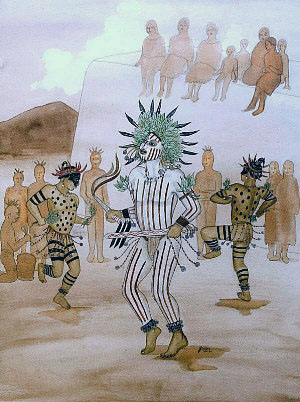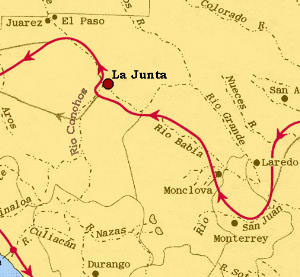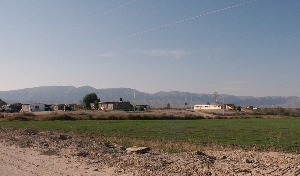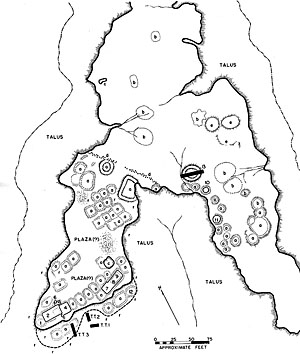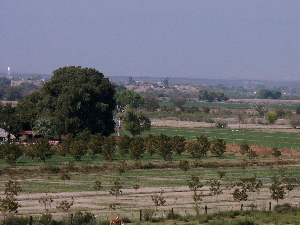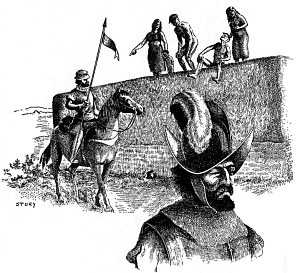Part-Time Farmers: |
When the Spanish first entered the Trans-Pecos they encountered settled peoples living in pueblos (villages) in the vicinity of Presidio, Texas who were part-time farmers. They called these people the Patarabueyes, a name that is actually three Spanish words combined into one: Patar (to kick), A (to or at), Bueyes (oxen). Around 1580, Spanish soldiers bestowed this name to the people who lived in the intermontain basin that today we call the Presidio Bolson. Here in this valley, the Conchos River, flowing north out of Mexico, confluences with the Rio Grande at what came to be known as La Junta de los Rios. The name Patarabueyes is significant in several ways. First, it is an example of how Spanish colonization served to change or muddle a pre-existing network of relationships among the native peoples of northern Mexico and Texas. The Spanish soldiers knew full well that the people of this valley had other names for themselves, names that had a history and a meaning to them and their neighbors. Yet when Mateo Gonzales led soldiers to the villages in the valley sometime around 1580, his purpose was to capture slaves to work in the silver mines recently discovered around Parral, Mexico, and to work on the large ranches east of Parral. Not surprisingly, the people in the villages did not cherish the idea of being forced into slavery and resisted in several ways, including kicking at oxen—perhaps oxen that had been brought to pull the carts that would be used to carry the captured Indians south. This act struck a chord with the soldiers and for some decades to come, Spanish documents would frequently use the nickname Patarbueyes when referring to the villagers in the valley. This act of applying a nickname based on a trait of a group was not uncommon. The Mansos of El Paso were sometimes called “Gorretas” (meaning cap or bonnet) because they wore their hair short, like a cap. Other examples include Los Que Hacen Arcos (Those Who Make Bows), Cabezas (Heads), and Palos Blancos (White Sticks or White Logs). As we will see below, the villages had distinct names, just as our towns and cities have different names today. Documents from the 1580s even indicate that two different languages were spoken in the valley and the people were all bilingual. The use of a nickname that lumped all villagers together obscured those differences and blurred the lines that made each group separate and unique. Nicknames used by the Spanish in the hand written documents employed by ethnohistorians to try to understand the native peoples of the Trans-Pecos make such study difficult. Many of the nicknames are never fully explained in the Spanish documents. Consequently, when other documents describe native peoples in the same general area, using the names the native people call themselves, it is often unclear if they were the same people as those given the nickname. The name “Palos Blancos” is only mentioned once and was said to refer to a group residing near the Patarabueyes’ villages, but the person who made the statement also said he had never been to the villages. As a result we do not know if he meant this group represented one of the villages, since they all had unique names, or if he meant another distinct people who had taken refuge in one of the villages or an entirely distinct group. In the case of the Patarbueyes, we know the explanation of the nickname. The explanation is provided in the journal of Diego Perez de Lujan (also spelled Luxan), the official scribe of the Espejo expedition to New Mexico in 1582-1583. In early December, 1582, Lujan wrote in his journal that the expedition traveled four leagues north along the Conchos River “and came to a rancheria of the Patarabueyes. The name Patarbueyes was made up by the soldiers when people from this same Rancheria were taken by Mateo Gonzales, head of Juan de Cubia, captain from the mines of Santa Barbara, because this very nacion that they named Patarabueyes are also called Otomoacos.” While the people living in La Junta may not have thought of themselves as the Patarabueyes and, in fact, may have thought that was a negative term, we use that term here. While they were variously called the Otomoacos and Abriaches in the 1580s, later we find that there were many other names and it is not clear which was the real name for them. In fact, it may well be that there was never a single, all encompassing name for the settled and sometimes-settled peoples who lived at La Junta. Consequently, we simply use the catchall term Patarabueyes, and we mean no disrespect to their memory. The year 1582 was not the first time the native people of La Junta had met Spaniards, nor was the visit by the soldiers their first time. Their first encounter was in 1535 when Alonso del Castillo and Estevanico, a black man, companions of Alvar Nunez Cabeza de Vaca in their long walk from the Texas Gulf Coast to Mexico City, were guided by two Indian women from groups living to the southeast of the valley that came to be known as La Junta. When Castillo returned to the camp where Cabeza de Vaca awaited them, he described what he had found in La Junta: “…houses of settled people and those people ate beans and calabashes and …he had seen maize [corn].” The journey of the Spaniards was remarkable and Cabeza de Vaca’s account, written after he arrived in Mexico City, contains a great deal of information about the native peoples the men met. However, his discussion of the native people of La Junta is particularly rich for two reasons. In their long journey made “naked and barefoot” the men had been exceedingly hungry. Native peoples they encountered had kindly shared food with them, but it was nowhere plentiful and the men essentially lived off the land. Since they were unfamiliar with the land, had never lived so before, and had no weapons, they seldom had enough to eat. In contrast, the people of La Junta had greater quantities of food and it was cultivated—something they had not seen since their ship was wrecked off the Texas coast. “This was the [one] thing on earth that made us most happy and for it we gave infinite thanks to Our Lord.” Second, these were the first people they had met who lived in permanent houses. These two facts impressed Cabeza de Vaca sufficiently that he provides considerable detail about “the people of the cows” as he called them. Cabeza de Vaca called them the people of the cows because he had been informed by the two women guiding them that most of the people were not present because they were away hunting bison (or cows). Krieger, however, argues persuasively that the people the women referred to were not the people of La Junta, pointing out the fact that the villagers, in fact, seemed to all be present. It seems likely that even at the time Cabeza de Vaca visited La Junta, there were already various different groups living there year-round or perhaps seasonally. Nonetheless, Cabeza de Vaca seems to have believed the women were referring to the people of La Junta in general. And, to add to his confidence, these people of the cows had bison robes and they talked to him about hunting bison. Like other native peoples encountered during the Spanish survivors’ long journey, the people of the cows are described as very generous, but had a newly seen custom: The next day we left [the first La Junta village] and took them [the people in the first village of settled Indians] with us to other permanent houses where they ate the same things. And from here on there was another new custom, that those who knew of our coming did not come out to receive us on the trails, as the others did, but instead we would find them in their houses. And, all were seated and had their faces toward the wall and their heads lowered and their hair pulled down over their eyes and their belongings in a pile in the center of the house. And from here on they began to give us many robes of hides and they had nothing that they would not give us. The custom is interesting. It suggests not only that the Patarabueyes were confident that they would not be harmed by any visitor entering their dwelling, but also that it may not have been considered polite to watch someone accepting gifts, even when freely given. Cabeza de Vaca went on to describe the people themselves: “They are people with the best bodies that we saw and the greatest liveliness and ability and who understood us best and responded to what we asked them.” One wonders just how the Spaniards were able to make themselves understood. No doubt in their years among the Indians of the Gulf Coast Cabeza de Vaca and his companions had learned to speak some of the local dialects. However, in the last year of their journey, they had already passed through several new language groups, and they also rarely stayed more than a few days or a few weeks with any one group, a time frame that was far too short to learn more than a few basic words. To give us a sense of how different the language of the Patarabueyes was from European languages, in 1582 Lujan recorded two group names for the villages (the Otomoacos and the Abriaches) and the names of several leaders in the Patarabueyes villages they visited: Baij Sibiye, Casica Moyo, and Q. Bisise. These names are phonetic renderings of their actual names, but they serve to show that their languages clearly differed from Spanish. One suspects that to “make themselves understood,” the Spaniards had perfected many skills in non-verbal communication such as perhaps bowing slightly to indicate deference, pointing to ask if something was available, etc. Krieger, in his exhaustive study of the journey, concludes that Cabeza de Vaca and his companions visited at least five villages in La Junta, and Cabeza de Vaca does state in his account that “the land was very populated.” Both of these accord well with the archeological evidence of the presence of numerous villages located along the Rio Grande in La Junta and also with statements made 46 years later during the 1581 and 1582 expeditions to New Mexico that each describe a series of villages in the valley. Still later descriptions, from the 17th and 18th centuries, again refer to up to fifteen named villages (some of which were along the Rio Conchos). Over time, the Spanish, and apparently even the native peoples occupying the villages, established Spanish names for each village. Below are the names and populations of the various groups who the Spanish found in these villages in the early and mid 18th century. |
| Village Loreto San Juan San Francisco Guadalupe San Jose San Antonio San Cristobal Aranzazu San Bernardino Pueblo of the Cibolos Tapacolme Santa Cruz Coyame San Pedro Cuchillo Parado |
Nation Mesquite Cacalotes Conejos Cholomes Posalmes Unknown Tecolotes Polacmes Unknown Puliques Cibolos Pescados Conchos Posalmes Conejos Tecolotes Cibolos Chisos bands Tapacolmes Cholomes, Conejoys, Tecolotes Cholomes Cholomes Conejos |
1714 Population Trasvina Retis 80 165 180 550 92 87 180 71 Unknown Unknown 300** Unknown 180 190 44 |
1747 Population Ydoiaga None 143 40 38 170 50 170 115 96 60 154 120 299 |
The table underscores some of the changes that had happened in the world of the Patarabueyes by the mid-1700s. In the 1500s, Cabeza de Vaca, Lujan, and other writers seem to describe a relatively unified people who had a close knit lifestyle. By 1747, over a third of the named villages had been abandoned. Moreover, some of the occupants were not native to the villages. The Conchos were native to the Conchos drainage, but originally lived well south of La Junta. The Cibolos and the Chisos were hunters and gatherers, not part of the original villagers. The Cibolos lived east of La Junta, while Spanish documents place the Chisos southeast of La Junta and south of the Rio Grande. However, in a policy decision that would eventually be adopted by the United States government, Spanish authorities found it expedient to “relocate” native peoples, particularly ones whom they believed had repeatedly engaged in attacks on Spanish ranches to the south. Finally, the village population listings portend the “blending” of native peoples. The Spanish were great note-takers. Everything was recorded—births, deaths, names, population counts, etc.—and scribes sent copies to various authorities. Yet, in 1747, entries of native names at San Francisco and Guadalupe are “unknown.” In other words the individual names of the natives began to be less important. They were simply “Indians” rather than the vibrant people described by Cabeza de Vaca. Indeed, in the 1767 travels of Bishop Tamaral y Ramon, the bishop lists the numbers of “Indians” at each village, but does not elaborate on their nacion. As villagers, there is a presumption that the Patarabueyes were farmers. It is true that they did grow crops. However, there is some fairly convincing evidence that they were only part-time farmers. First, even in the earliest contact with them, Cabeza de Vaca and his companions asked why they had beans and calabashes (likely pumpkin or other edible squash) but not corn. Cabeza de Vaca wrote: They answered us that they did not do it so as not to lose what they planted, because for two years in succession rains had failed and the seasons had been so dry that all the maize they had had been eaten by moles, and they no longer dared to plant until there was much rain first. The Ydoiaga report of 1747, which has been translated by Enrique Madrid, also talks of the limitations of agriculture in La Junta. The Posalmes, for example, told Ydoiaga that crops were often insufficient and they “sustained themselves with some fish, atoll from various seeds of plants, tunas, and other things from the hunt.” As discussed in the La Junta exhibit (see New Insights), recent analysis of human remains dating to the pre-Spanish era (A.D. 1200-1450), revealed that corn represented less than 25 percent of the diet of the villagers buried at the Millington site (known to the Spanish as Santiago and San Cristobal). These data suggest that life in the valley was risky. Such a light dependence on crops may reflect the type of risk and uncertainty that has also been documented in the western Trans-Pecos among the El Paso phase villages. So, how did the people of La Junta buffer this uncertainty? First, their stone tools were quite similar to those used by foraging (hunting and gathering) peoples in the area, and included projectile points suitable for hunting game, hide skinning tools, and so on. The bison robes seen by Cabeza de Vaca indicate that their hunts were successful. Archeological evidence indicates that they also ate cacti, mesquite beans, rabbits, deer, and other wild plant and animal foods. And, like us, they had another important means to buffer risk. Specifically, they had mutualistic relationships with friends that could help them ameliorate troublesome times. Mutualistic here is used in the sense that both parties received a benefit from their relationships. The relationships typical of the Patarabueyes and their friends are discussed at length in author Kenmotsu’s 1993 dissertation entitled Helping Each Other Out, a Study of the Mutualistic Relations of Small Scale Foragers and Cultivators in La Junta de los Rios Region, Texas and Mexico. Interested in how small groups of cultivators might interact with their neighbors who were hunters and gatherers, she studied the Patarabueyes largely using Spanish documents written in the 16th through the 18th centuries. In those documents, Kenmotsu found evidence of their friendships with other groups, particularly groups to the south. Among those close friends were the Chisos, Conchos, Julimes, and Mamites. These relationships were first noted in the 1580s when the Spanish recognized a friendship of the Conchos and Julimes—hunters and gatherers who lived south of La Junta on the Conchos drainage—with the nations living in La Junta. Anthropologists have found that if these friendships endure for long periods of time, they become especially close during times of stress. Certainly, the era of Spanish colonization was a time of extreme stress for the native peoples of the Trans-Pecos including those living in La Junta. Slaves were taken from many villages and rancherias (camps); new diseases were introduced; and the Spanish intruders brought many new customs and changes—some that the native peoples did not like or want. In New Mexico, the most vivid evidence of that dislike was the Pueblo Revolt of 1680. Other native revolts occurred in Nueva Vizcaya in the 1640s and the 1680s. While none of these revolts directly involved the lands of La Junta, the people of La Junta provided strong support for their friends to the south during the Nueva Vizcaya rebellions. Hence in 1645, Francisco Montano de la Cueva wrote an order for his war captains to find out the cause of “this new uprising and what has caused the nations Conchos, Mamites, Julimes, Bacichilimes, Mosnales, Olozames, Xiximibles, Oposmes, Chisos, and the others who are allied with them to rebel.” In a subsequent document, he notes that the whole province of Nueva Vizcaya was in danger of “being lost.” No doubt the same sentiment was felt by the native peoples. In both this and the 1684 war, the rebel Conchos, Julimes, and Mamites used La Junta as their staging area. Don Hernando de Obregon, a Mamite, led both rebellions and of the 29 nations under his command, all but one of the La Junta nations (the Pescados) was listed among the rebels. Nations in or close to La Junta that witnesses said participated in the 1684 rebellion under Obregon include the Pusalmes, Polacmes, Cacalotes, Conejos, Cholomes, Conchos, and many of the Chisos bands. While these alliances were powerful and long-lived, witnesses show that individuals operated under a system of free will. Lucas, a Tapalcome from La Junta, testified during the 1684 war that he had recently been to La Junta where Obregon was the leader. In addition to Obregon, a Concho named Domingo Toaagua (or Taagua) was an important figure in La Junta. Lucas testified that he had heard of Toaagua for two years. Toaagua was a messianic leader who is believed to have convinced many of the nations, such as the Conchos and Julimes, to move north and away from the Spanish. He testified that one day Toaagua was at the church in the La Junta village of San Cristobal (village of the Posalmes) when a voice said to him (Toaagua) that he was a religious man and could not be hurt by guns or swords. All the assembled people bowed three times to him and kissed his hand. The assembly included more than 1,000 native people. Later, Anton Auchi, another Tapalcome from La Junta testified that he too had observed Toaagua. Tooagua claimed that he never ate, but in fact Anton had gone to the dances being held in La Junta and saw Toaagua eating meat, bread, and watermelon. The alliances served in other ways. Shortly before the 1684 war, a sizable group of Conchos and Julimes moved north and settled in the pueblos at La Junta; three decades later in 1715 they still resided there in San Antonio de Padua. In the 1690s and early 1700s the principal governors of La Junta were often said to be Julimes, an indication that the La Juntans felt comfortable enough with their friends to even accept them as leaders. The Chisos, hunters and gatherers whose lands were to the southeast of La Junta, were often associated with La Junta during the 17th and 18th centuries. The table below shows the names of a number of their bands that can be documented for the years 1600 through 1699. They also were said to have participated in the 1645 rebellion and some were in La Junta. Interestingly, this closeness came at a time when the Chisos were being attacked by the Tobosos, a nation that occupied some of the desert regions in the Bolson de Mapimi, today in the Mexican state of Coahuila. Over the next 50 years one or another of the Chisos bands resided in or close to La Junta. During the 1684 rebellion, the Cacalotes, a Chisos band, established residency in San Juan Bautista one of the La Junta pueblos with the Conejos, one of the La Junta native groups. By the 1720s Don Alonso, a Chiso, was listed as the principal leader in that village. The documents strongly suggest these relationships and alliances were cemented through exchange of food, material goods, and information. In 1535, Cabeza de Vaca and his companions, including the two native women who had led them to La Junta, were given food and blankets by the Patarabueyes. In the 1580s, the Spanish expeditions were given food and “whatever else …[the villagers] possessed.” In 1654, a Mamite and a Concho were apprehended with stolen Spanish horses that they were taking to La Junta to trade. While these and other examples illustrate trade in food and material goods, the documents indicate two other things: first, little food was brought into La Junta. Not until around 1750 is there documentation that meat was traded in to the villages. Second, most exchange was in information. When the Spanish arrived in La Junta in 1582, the small villages had known of their coming long before they arrived. Information related to enemies was particularly well documented, and natives in La Junta and elsewhere had accurate and detailed knowledge of who had rebelled, where, and when. In the 1684 rebellion, the nations at La Junta were aware of the battles and other tactical moves faster and more accurately than the Spanish (who were actively engaged in the conflict) through the use of runners moving up and down the Conchos. The news network was invoked over even longer distances. When Retana questioned Cibolos in La Junta, he learned that they had traded and bargained with messengers sent by other Cibolos who were at that time in what is now east Texas some 500 miles to the east. Information as a form of exchange is well known to anthropologists. As Gregory Johnson put it, in risky environments “How are things at home?” may well be the first question asked of any visitor. The relationships of the La Junta villages with other nations the documents show that the relationships spread in all directions from them and argues that this was a strategy to spread risk during uncertain times. To their south, the villagers had a long standing friendship with the Conchos, Julimes, and Mamites as early as the 1580s and continuing until at least 1750. The Chisos to the east and southeast, were friends of the villagers from at least the 1640s. In 1690 Retana settled some 300 Chisos in La Junta because “they were friends of the people there.” The Jumanos to the northeast were also friendly with the people of La Junta, although less frequently found among them. Finally, the Cholomes situated to the northwest along the Rio Grande were also close to the La Junta villagers and sporadically resided with them. Clearly, this network surrounded the Presidio Bolson, and through the network, using runners as they had in rebellions and when the first Spanish expeditions came to their villages, the people of La Junta were well advised in advance of important events in their world. It was this network that allowed the pueblos (small villages) that had been constructed in La Junta to continue to be built, abandoned, and re-occupied right into the historic era. Interestingly, they continued even though the pueblos in El Paso were abandoned around A. D. 1450. Although J. Charles Kelley argued that La Junta may have been abandoned from A.D. 1450-1550, there is no convincing archeological data of an hiatus and Cabeza de Vaca visited a well-populated La Junta in 1535. The ceramics changed: El Paso Polychrome, which had been used in the first villages at La Junta, was discontinued after 1450, but new locally made wares took its place. While individual houses became larger, the basic construction techniques continued and other aspects of the material culture continued with little change. This continuation [survival beyond A.D. 1450] was due in part to the friendships that the La Junta phase people had developed first with the hunters and gatherers who lived outside their valley. Such relationships represent one technique for groups in risky environments, like the Chihuahuan desert, to manage that risk. The survival of the small villages was not a simple thing. Aware of the rebellions initiated against the Spanish by the Conchos, Tobosos, Sumas, and others, they recognized that they had to take sides. While they sided with the rebels in the early 17th century, when the Sumas attacked in the mid-18th century the people of La Junta feared the consequences and aided the Spanish. The Spanish also settled others among them, including the Chisos and some Conchos swelling their ranks and requiring adjustments just as we make when relatives or friends move in. Yet the Chisos and Conchos had a long and well established friendship with the people of La Junta. Nonetheless, the Chihuahuan desert environment is drought-prone and even in a valley with the confluence of two major rivers, water can be insufficient to grow crops. Hence, food was always a prominent concern. Despite these concerns, some of the La Junta villages remained over the years, although by 1765 the residents were labeled simply as “Indians” rather than their rich, varied names given centuries earlier. Still, they survived. Today, Tapalcolmes is called Redford or Polvo (meaning dust in Spanish). Puliques, situated just south of the Rio Grande, continued as a small village until the early 20th century. The village of Polacmes or Nuestra Senora de Guadalupe is today covered by the Mexican city of Ojinaga. Coyame, a village south of Ojinaga, is only one of the villages to still carry its original name. If you visit Presidio today, take the time to glance at the mountains surrounding it. Think of its rich history that long predates Spanish and European intrusions and consider what life was like when Cabeza de Vaca and his companions first came here in 1535.
|
|
||||||
